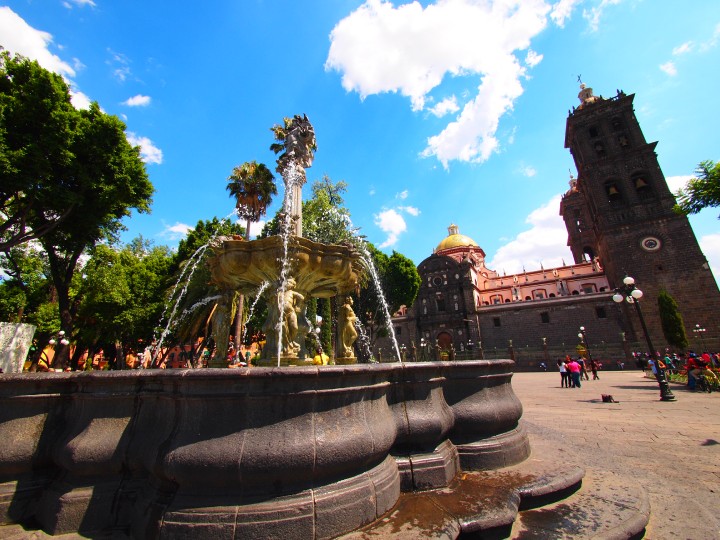We stayed overnight in Puebla to meet our mountain guide “Oso” (The Bear) the next day to start our hiking trip to Pico de Orizaba. We were only there a short time but we really enjoyed the atmosphere in Puebla. The town is bustling, clean, and had more foreign tourists than any other place we’ve been on this trip. The town square (Zocalo) is blocked from auto traffic on the weekends, and it becomes a very festive, family friendly kind of carnival in the center of the city. The town is known for it’s candy shops, and there’s actually an entire street lined with just candy shops. The shops primarily sell traditional Mexican treats like candied fruit and nuts. However, there are a few treats that are unique to Puebla. One of them, and one that seems to be loved by many, is called camotes. Camotes are like little natural fruit tootsie rolls (except bigger), and I gotta say, they have a really disgusting gritty texture that I didn’t care for. They also tasted entirely too “natural”, that is, not nearly enough sugar, chemicals, and coloring. When I say I want strawberry, or lime, or orange candy, what I really want is “strawberry”, or “lime”, or “orange” candy. Another sweet treat to be found only in Puebla is called “Tortitas de Santa Clara”, and these things were an entirely different story. They are very understated looking cookies with pie crust edges and a custard looking topping. They’re almost indescribable though: tart, salty, sweet. Flavors like crushed almond and lemon…. contrasts in texture and flavor. They were good enough that we made a return trip on the way back from the hiking trip to bring a small stock home.
Walking around downtown Puebla, the main architectural landmark is the cathedral adjacent to the zocalo. Constructed in the 1500’s, it is a really imposing structure, inside and out.

The inside of the cathedral (like the few catholic churches I’ve been inside) has all sorts of side rooms devoted to various saints and local oddities. The main area inside is really divided up though, so it’s hard to capture how overwhelming and large a structure this is. Each chandelier (or whatever they are) could impale like 5-10 people.

And now, while I’ve certainly never been accused of being a religious person, maybe I just don’t “get” this. Seriously though, I don’t get this:

Another interesting thing in Puebla is the Italian influence on local food. Immigrants from northern Italy settled there in the 1800s, and there is actually an area outside of Puebla where an Italian dialect is still spoken. In Puebla though there are many restaurants that specialize in Italian cuisine. This is not the sort of stuff you’d expect from the North End in Boston, or Little Italy in NYC. It’s fairly unique, and what’s interesting is the way Italian dishes are fused with Mexican flavors. We went to a place called Vittorio’s that was adjacent to the zocalo. She got their lasagna, which looked pretty typical (and delicious), although the meat and marinara sauce were really uniquely flavored. Very good.
 I grabbed a more traditional (and I guess boring) Mexican dish of Mole Poblano. Although I suppose it’s interesting simply that they’re both on the same menu.
I grabbed a more traditional (and I guess boring) Mexican dish of Mole Poblano. Although I suppose it’s interesting simply that they’re both on the same menu.
 Finally, amongst their many coffee and espresso selections were some uniquely Mexican combinations, such as cappuccino with tequila and cappuccino with rompope. Rompope is a traditional Mexican drink that kind of resembles alcoholic eggnog. It’s good by itself, and it seemed like a good combination in a cappuccino. It was.
Finally, amongst their many coffee and espresso selections were some uniquely Mexican combinations, such as cappuccino with tequila and cappuccino with rompope. Rompope is a traditional Mexican drink that kind of resembles alcoholic eggnog. It’s good by itself, and it seemed like a good combination in a cappuccino. It was.
Oh yeah, and we can’t forget “The Italian Coffee Company.” It’s a Mexican coffee shop chain started in Puebla with typical Starbucks-esque fare. They do have a pretty direct Mexican equivalent of my absolute favorite Cuban coffee drink, the “Cortadito.” On their menu, it is called “Espresso Cortado.” It really is the same drink though, and it really is delicious.

Also, I was both surprised and comforted to be informed by the kind folks at the Italian Coffee company that coffee basically cures all disease. I wonder why they can’t print this stuff on American coffee chain napkins? (Translation: Did you know that coffee: fills you with energy, reduces risk of developing cancer, reduces risk of Parkinson’s, improves asthma and allergies, reduces risk of developing diabetes, cirrhosis, or Alzheimer’s, awakens the senses and improves short term memory, reduces headaches, prevents blood clots, is a potent antioxidant, is a diuretic, and is an excellent source of potassium, magnesium, and fluoride) The headache part is particularly clever, especially if you start making a daily habit of double espresso cortado’s.

Definitely a very pretty town with a nice vibe and great food. This is the view from our hotel room. On the horizon is Popocatepetl, an active volcano (and not part of our hiking trip).



5 thoughts on “Passing through Puebla”
Mexican-Italian food? Count me IN! On a side note, that pic of Jesus reminded me a little bit of my brother, Steven, the morning after our first night in Key West.
Greg, I think you would like that combo! As far as the Jesus pic, Mike asked for an explanation, and I had none. Maybe to guilt trip people to stop them from stealing the donation money? LOL.
I wouldn’t have thought you’d find italian in Mexico but it definitely sounds like an interesting fusion of flavors. That lasagna looked delicious. Too bad there was no Mike’s Pastry…a cannoli would go well with that coffee.
I was surprised too. It was definitely unique and tasty! The decor was an equally seamless fusion. People there actually spoke Italian (Or from what I read, an 18th century Venetian dialect). Thanks for following Ingrid. (Sorry I posted this in the wrong spot at first).